Study on the Adsorption Behavior of Polymeric Dispersants to S-ZnF Particles during Grinding Process
Abstract
:1. Introduction
2. Experimental Section
2.1. Materials
2.2. Synthesis of Polymeric Dispersants
2.3. Grinding Process of S-ZnF Particles
2.4. Characterizations
3. Results and Discussion
3.1. Water-Based Dispersants PD0x
3.2. Grinding of the S-ZnF Particles
3.3. Adsorption Thermodynamic Analysis
3.4. Adsorption Kinetics Analysis
3.5. Adsorption Diagram
4. Conclusions
Author Contributions
Funding
Institutional Review Board Statement
Informed Consent Statement
Data Availability Statement
Conflicts of Interest
References
- Qin, W.; Wang, K.; Zhang, Y. Preparation of submicron CdSxSe1−x@ZrSiO4 inclusion pigment and its application in ink-jet printing. J. Eur. Ceram. Soc. 2021, 41, 7878–7885. [Google Scholar] [CrossRef]
- Zhang, Y.; Zeng, D.; Rao, P.; Cao, A.; Wu, J. Hydrothermal synthesis of cadmium sulfoselenide inclusion pigment. J. Sol-Gel Sci. Technol. 2008, 48, 289–293. [Google Scholar] [CrossRef]
- Liu, H.; Gao, H.; Long, M.; Fu, H.; Alvarez, P.J.; Li, Q.; Zheng, S.; Qu, X.; Zhu, D. Sunlight Promotes Fast Release of Hazardous Cadmium from Widely-Used Commercial Cadmium Pigment. Environ. Sci. Technol. 2017, 51, 6877–6886. [Google Scholar] [CrossRef] [PubMed]
- Zhou, J.; Rao, P.; Ke, S.; Zhang, T. Preparation and characterization of ZnFe1.2Cr0.8O4 water-based ceramic inks obtained using a polymeric dispersant. J. Dispers. Sci. Technol. 2022, 2022, 2050923. [Google Scholar] [CrossRef]
- Özkol, E. Rheological characterization of aqueous 3Y-TZP inks optimized for direct thermal ink-jet printing of ceramic components. J. Am. Ceram. Soc. 2013, 96, 1124–1130. [Google Scholar] [CrossRef]
- Özkol, E.; Zhang, W.; Ebert, J.; Telle, R. Potentials of the direct inkjet printing method for manufacturing 3Y-TZP based dental restorations. J. Eur. Ceram. Soc. 2012, 32, 2193–2201. [Google Scholar] [CrossRef]
- Özkol, E.; Ebert, J.; Telle, R. An experimental analysis of the influence of the ink properties on the drop formation for direct thermal inkjet printing of high solid content aqueous 3Y-TZP suspensions. J. Eur. Ceram. Soc. 2010, 30, 1669–1678. [Google Scholar] [CrossRef]
- Woo, K.; Jang, D.; Kim, Y.; Moon, J. Relationship between printability and rheological behavior of ink-jet conductive inks. Ceram. Int. 2013, 39, 7015–7021. [Google Scholar] [CrossRef]
- Polsakiewicz, D.A.; Kollenberg, W. Highly loaded alumina inks for use in a piezoelectric print head. Mater. Sci. Eng. Technol. 2011, 42, 812–819. [Google Scholar] [CrossRef]
- Cappi, B.; Ebert, J.; Telle, R. Rheological properties of aqueous Si3N4 and MoSi2 suspensions tailor-made for direct inkjet printing. J. Am. Ceram. Soc. 2011, 94, 111–116. [Google Scholar]
- Kuscer, D.; Stavber, G.; Trefalt, G.; Kosec, M. Formulation of an aqueous titania suspension and its patterning with ink-jet printing technology. J. Am. Ceram. Soc. 2012, 95, 487–493. [Google Scholar] [CrossRef]
- Liu, Y.; Huang, G.; Pan, Z.; Wang, Y.; Li, G. Synthesis of sodium polyacrylate copolymers as water-based dispersants for wet ultrafine grinding of cobalt aluminate particles. Coll. Surf. A 2021, 610, 125553. [Google Scholar] [CrossRef]
- Huang, G.; Pan, Z.; Wang, Y. Synthesis of sodium polyacrylate copolymers as water-based dispersants for ultrafine grinding of praseodymium zirconium silicate. Coll. Surf. A 2018, 558, 591–599. [Google Scholar] [CrossRef]
- He, M.; Wang, Y.; Forssberg, E. Slurry rheology in wet ultrafine grinding of industrial minerals: A review. Powder Technol. 2004, 147, 94–112. [Google Scholar] [CrossRef]
- Shahid, M.; Farooqi, Z.H.; Begum, R.; Irfan, A.; Azam, M. Extraction of cobalt ions from aqueous solution by microgels for in-situ fabrication of cobalt nanoparticles to degrade toxic dyes: A two fold-environmental application. Chem. Phys. Lett. 2020, 754, 137645. [Google Scholar] [CrossRef]
- Arif, M.; Farooqi, Z.H.; Irfan, A.; Begum, R. Gold nanoparticles and polymer microgels: Last five years of their happy and successful marriage. J. Mol. Liq. 2021, 336, 116270. [Google Scholar] [CrossRef]
- Li, Z.; Pan, Z.; Wang, Y. Mechanochemical preparation of ternary polyethyleneimine modified magnetic illite/smectite nanocomposite for removal of Cr(VI) in aqueous solution. Appl. Clay Sci. 2020, 198, 105832. [Google Scholar] [CrossRef]
- Arif, M.; Shahid, M.; Irfan, A.; Nisar, J.; Wang, X.; Batool, N.; Begum, R. Extraction of copper ions from aqueous medium by microgel particles for in-situ fabrication of copper nanoparticles to degrade toxic dyes. Zeitschrift für Physikalische Chemie 2022, 236, 1219–1241. [Google Scholar] [CrossRef]
- Naseem, K.; Begum, R.; Wu, W.; Usman, M.; Irfan, A.; Al-Sehemi, A.G.; Farooqi, Z.H. Adsorptive removal of heavy metal ions using polystyrene-poly (N-isopropylmethacrylamide-acrylic acid) core/shell gel particles: Adsorption isotherms and kinetic study. J. Mol. Liq. 2019, 277, 522–531. [Google Scholar] [CrossRef]
- Arif, M. Complete life of cobalt nanoparticles loaded into cross-linked organic polymers: A review. RSC Adv. 2022, 12, 15447–15460. [Google Scholar] [CrossRef]
- Lei, S.; Shi, Y.; Qiu, Y.; Che, L.; Xue, C. Performance and mechanisms of emerging animal-derived biochars for immobilization of heavy metals. Sci. Total Environ. 2019, 646, 1281–1289. [Google Scholar] [CrossRef]
- Sharifipour, F.; Hojati, S.; Landi, A.; Faz Cano, A. Kinetics and thermodynamics of lead adsorption from aqueous solutions onto Iranian sepiolite and zeolite. Int. J. Environ. Res. 2015, 9, 1001–1010. [Google Scholar]
- Peng, J.; Qu, J.; Zhang, J.; CHen, M.; Wan, T. Adsorption characteristics of water-reducing agents on gypsum surface and its effect on the rheology of gypsum plaster. Cem. Concr. Res. 2005, 35, 527–531. [Google Scholar] [CrossRef]
- Farrokhpay, S.; Morris, G.E.; Fornasiero, D.; Self, P. Effects of chemical functional groups on the polymer adsorption behavior onto titania pigment particles. J. Colloid Interface Sci. 2004, 274, 33–40. [Google Scholar] [CrossRef] [PubMed]
- Ran, Q.; Somasundaran, P.; Miao, C.; Liu, J.; Wu, S.; Shen, J. Effect of the length of the side chains of comb-like copolymer dispersants on dispersion and rheological properties of concentrated cement suspensions. J. Colloid Interface Sci. 2009, 336, 624–633. [Google Scholar] [CrossRef] [PubMed]
- Li, C.C.; Chang, S.J.; Wu, C.W.; Chang, C.W.; Yu, R.H. Newly designed diblock dispersant for powder stabilization in water-based suspensions. J. Colloid Interface Sci. 2017, 506, 180–187. [Google Scholar] [CrossRef]
- Langmuir, I. The adsorption of gases on plane surfaces of glass, mica and platinum. J. Am. Chem. Soc. 1918, 40, 1361–1403. [Google Scholar] [CrossRef]
- Singh, D.; Singh, S.K.; Atar, N.; Krishna, V. Amino acid functionalized magnetic nanoparticles for removal of Ni(II) from aqueous solution. J. Taiwan Inst. Chem. Eng. 2016, 67, 148–160. [Google Scholar] [CrossRef]
- Li, Z.; Pan, Z.; Wang, Y. Preparation of ternary amino-functionalized magnetic nano-sized illite-smectite clay for adsorption of Pb(II) ions in aqueous solution. Environ. Sci. Pollut. Res. 2020, 27, 11683–11696. [Google Scholar] [CrossRef]
- Li, Z.; Pan, Z.; Wang, Y. Enhanced adsorption of cationic Pb(II) and anionic Cr(VI) ions in aqueous solution by amino-modified nano-sized illite-smectite clay. Environ. Sci. Pollut. Res. 2019, 26, 11126–11139. [Google Scholar] [CrossRef]
- Wu, F.C.; Tseng, R.L.; Juang, R.S. Characteristics of Elovich equation used for the analysis of adsorption kinetics in dye-chitosan systems. Chem. Eng. J. 2009, 150, 366–373. [Google Scholar]
- Huang, G.; Pan, Z.; Wang, Y. Ultrafine Grinding of Praseodymium Zirconium Silicate Pigment with Water-based Hydroxyl Modified Dispersants. J. Chin. Ceram. Soc. 2019, 47, 1776–1783. [Google Scholar]
- Huang, G.; Pan, Z.; Wang, Y. Dispersion of praseodymium-doped zirconium silicate pigment in aqueous suspension by modified hydroxyl copolymer. Chem. Eng. Res. Des. 2020, 154, 86–100. [Google Scholar] [CrossRef]
- Güngör, G.L.; Kara, A.; Blosi, M.; Gardini, D.; Guarini, G.; Zanelli, C.; Dondi, M. Micronizing ceramic pigments for inkjet printing: Part I. Grindability and particle size distribution. Ceram. Int. 2015, 41, 6498–6506. [Google Scholar] [CrossRef]
- Eren, E. Removal of lead ions by Unye (Turkey) bentonite in iron and magnesium oxide-coated forms. J. Hazard. Mater. 2009, 165, 63–70. [Google Scholar]
- Xu, W.; Song, Y.; Dai, K.; Sun, S.; Liu, G.; Yao, J. Novel ternary nanohybrids of tetraethylenepentamine and graphene oxide decorated with MnFe2O4 magnetic nanoparticles for the adsorption of Pb(II). J. Hazard. Mater. 2018, 358, 337–345. [Google Scholar]
- Shaw, D.J. Introduction to Colloid and Surface Chemistry, 3rd ed.; Butterworth-Heinemann: Oxford, UK; Boston, MA, USA, 1992. [Google Scholar]
- Nakamoto, K. Infrared and Raman spectra of inorganic and coordination compounds. In Part A: Theory and Applications in Inorganic Chemistry; John Wiley & Sons, Inc.: Hoboken, NJ, USA, 2009; pp. 16394–16395. [Google Scholar]
- Olhero, S.M.; Garcia-Gancedo, L.; Button, T.W.; Alves, F.J.; Ferreira, J.M. Ferreira, Innovative fabrication of PZT pillar arrays by a colloidal approach. J. Eur. Ceram. Soc. 2012, 32, 1067–1075. [Google Scholar]
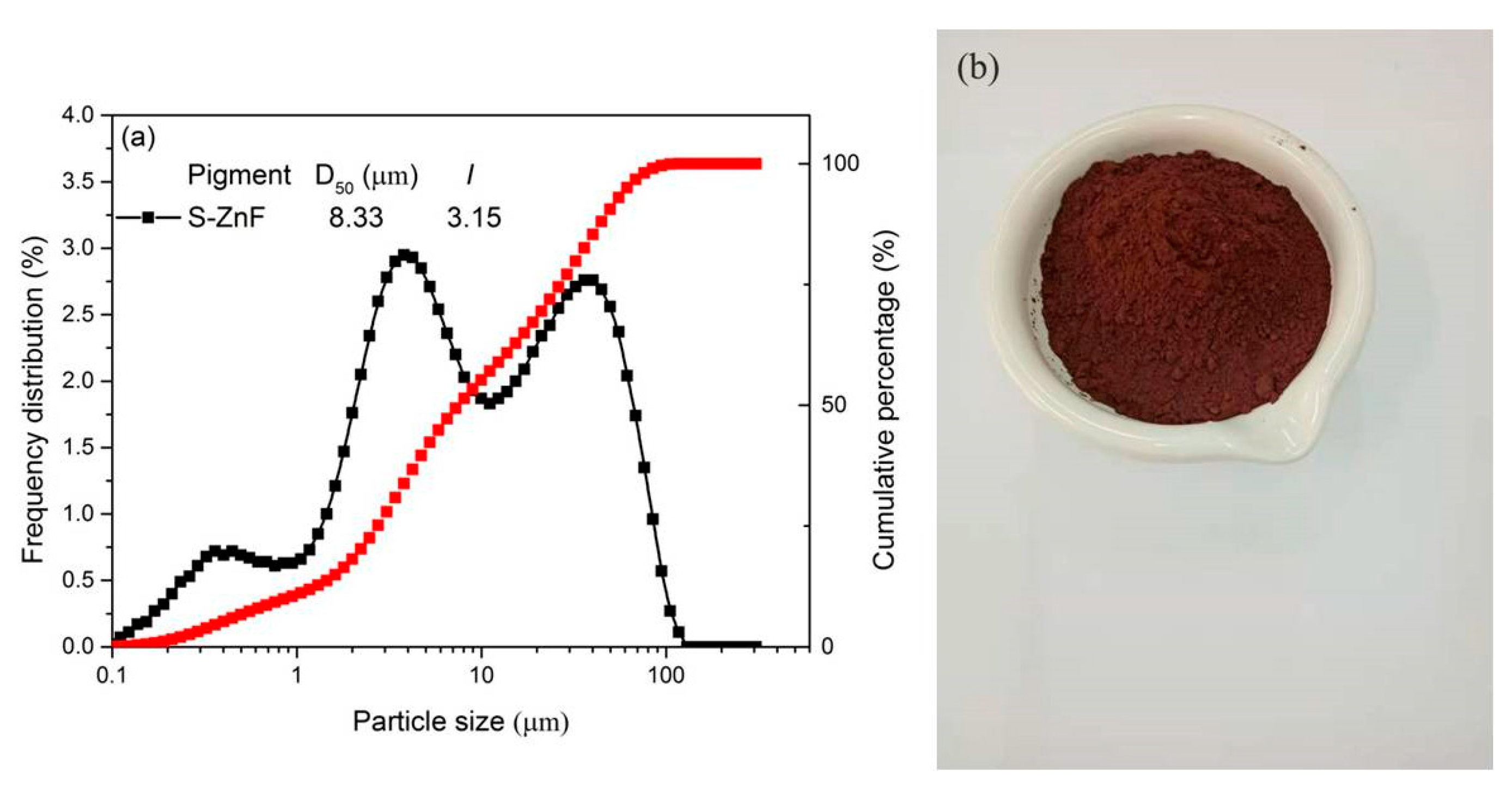
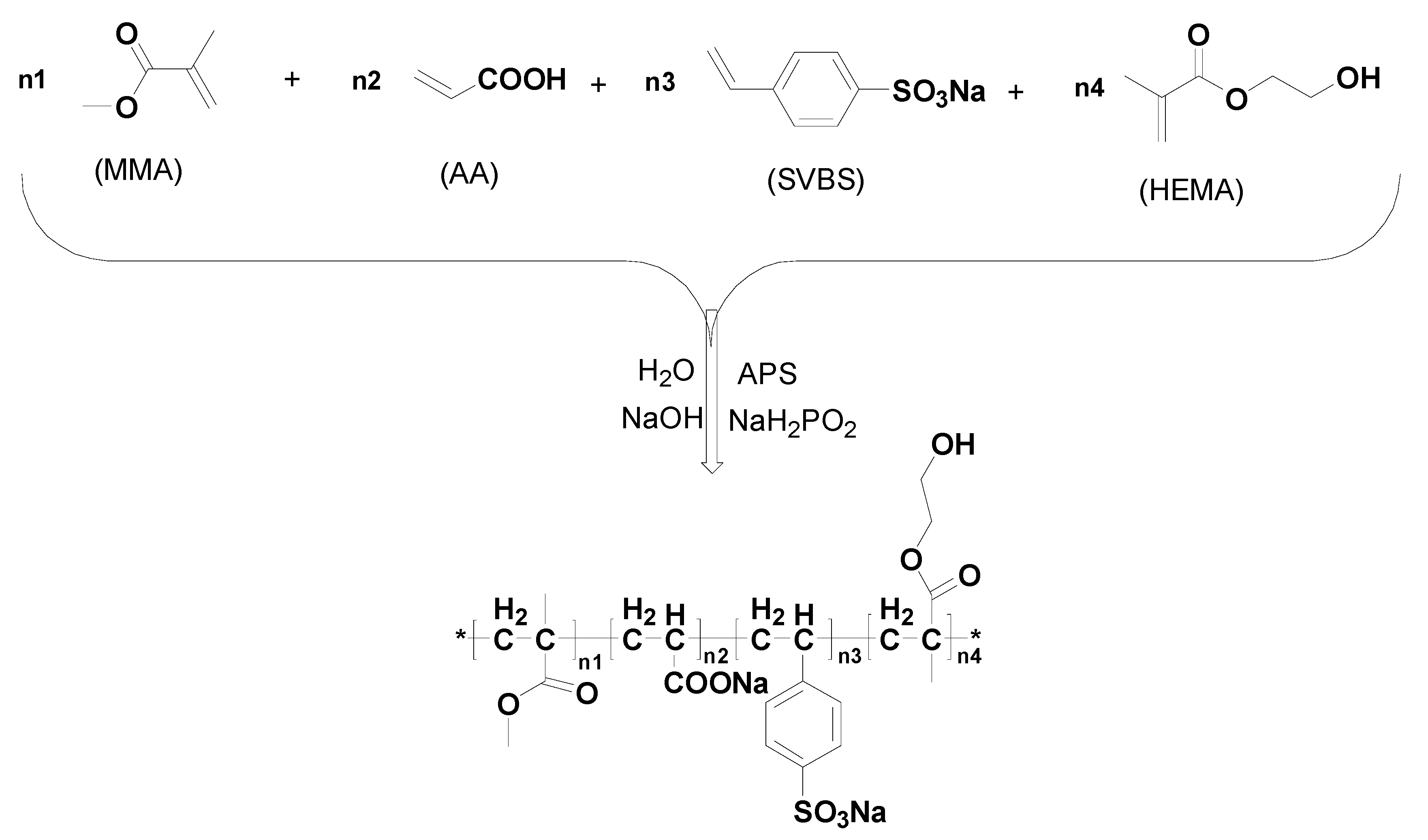
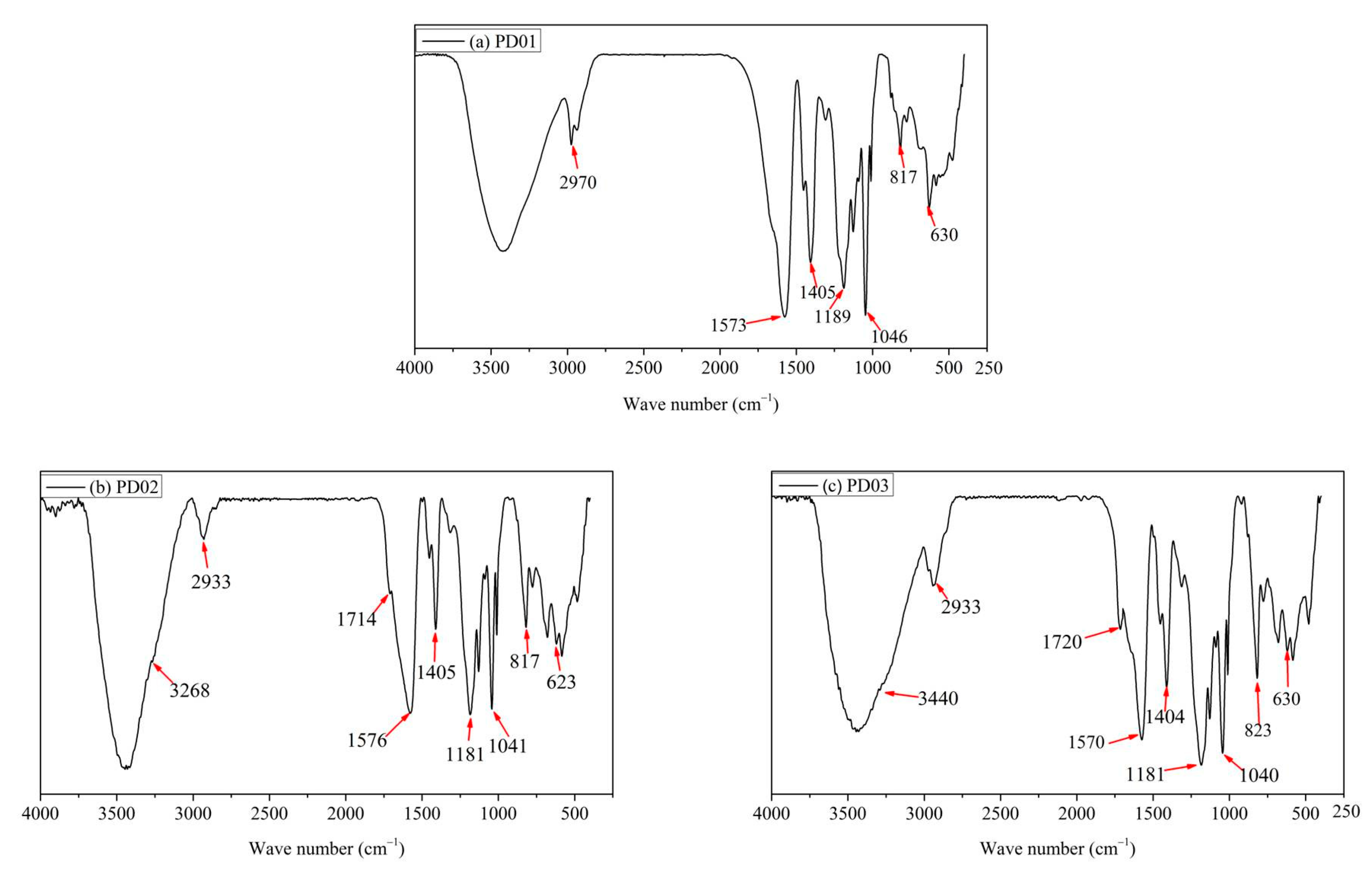
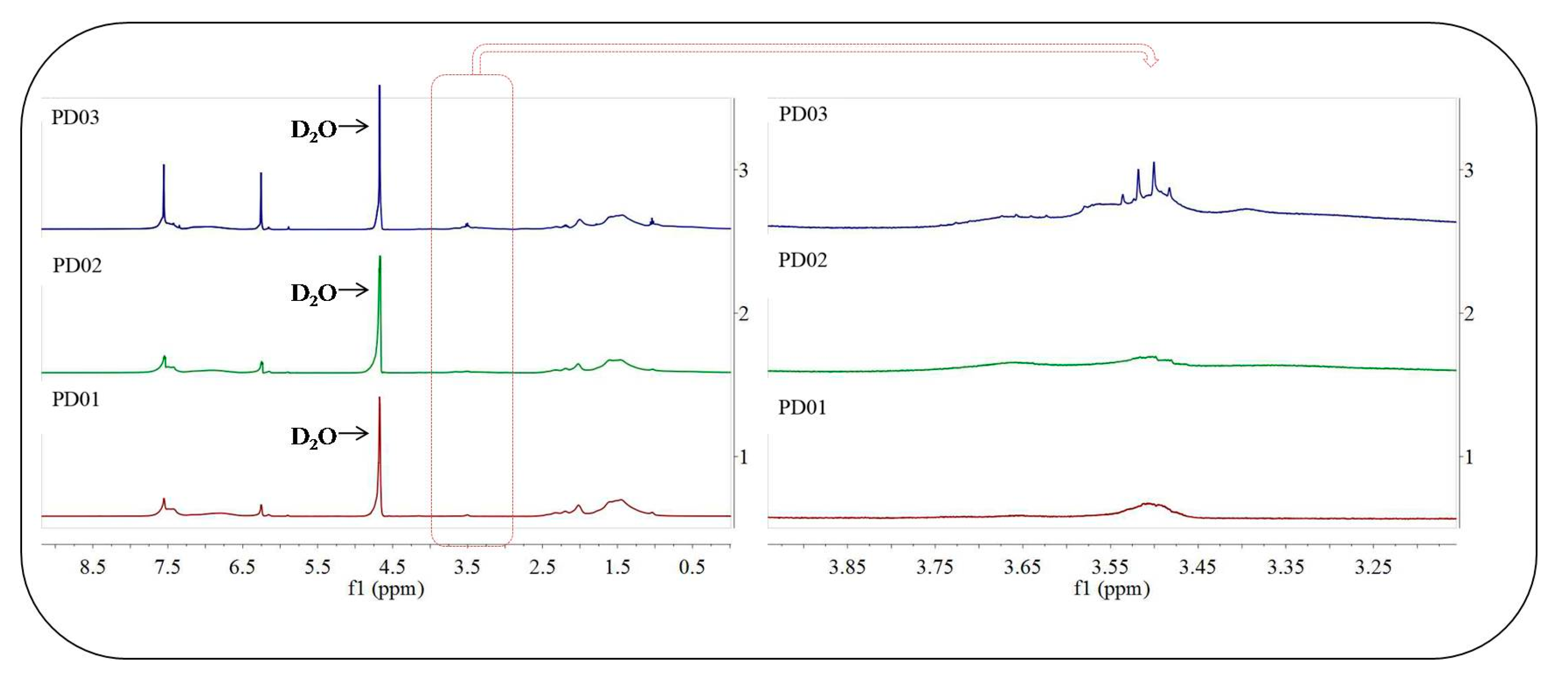
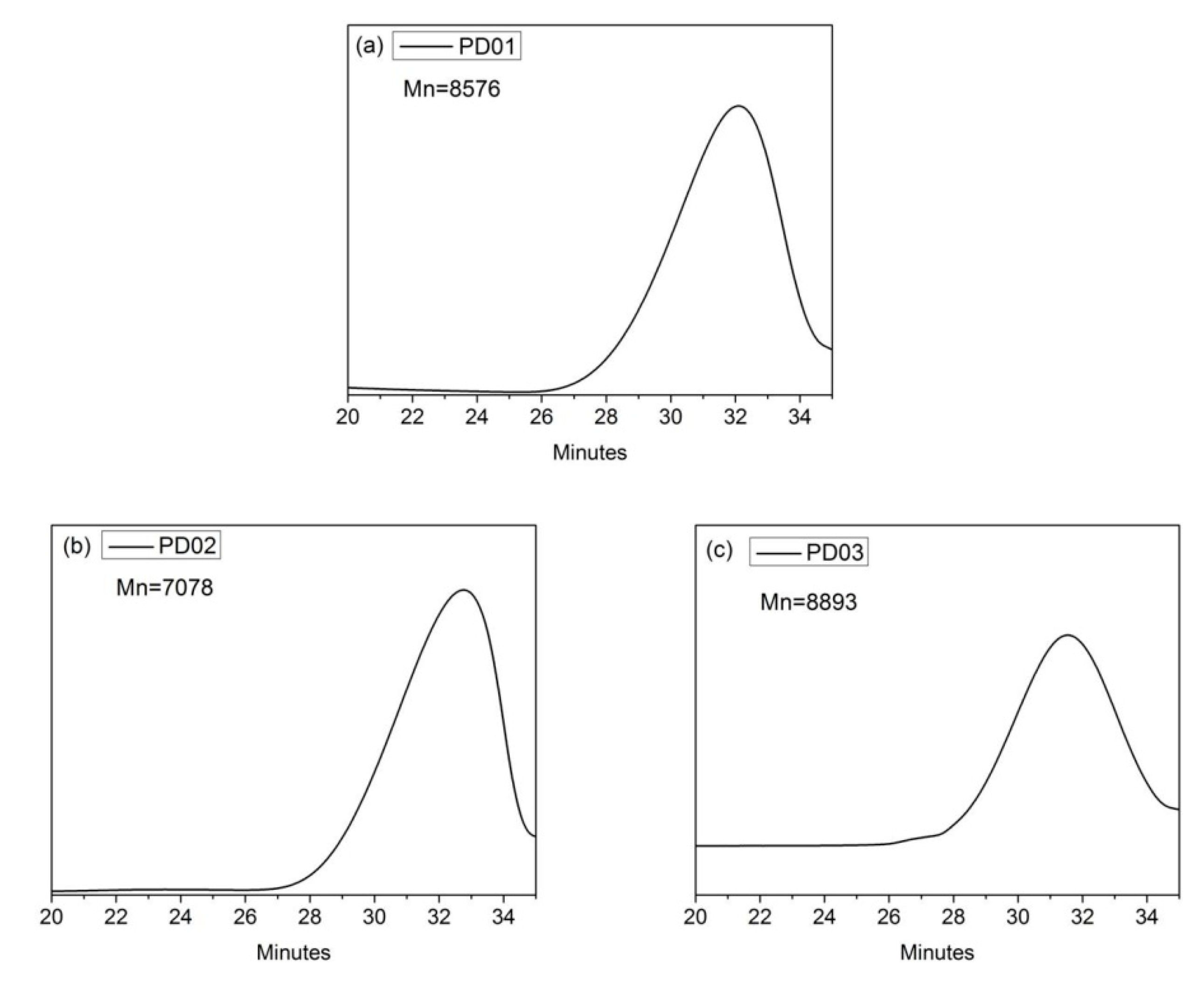
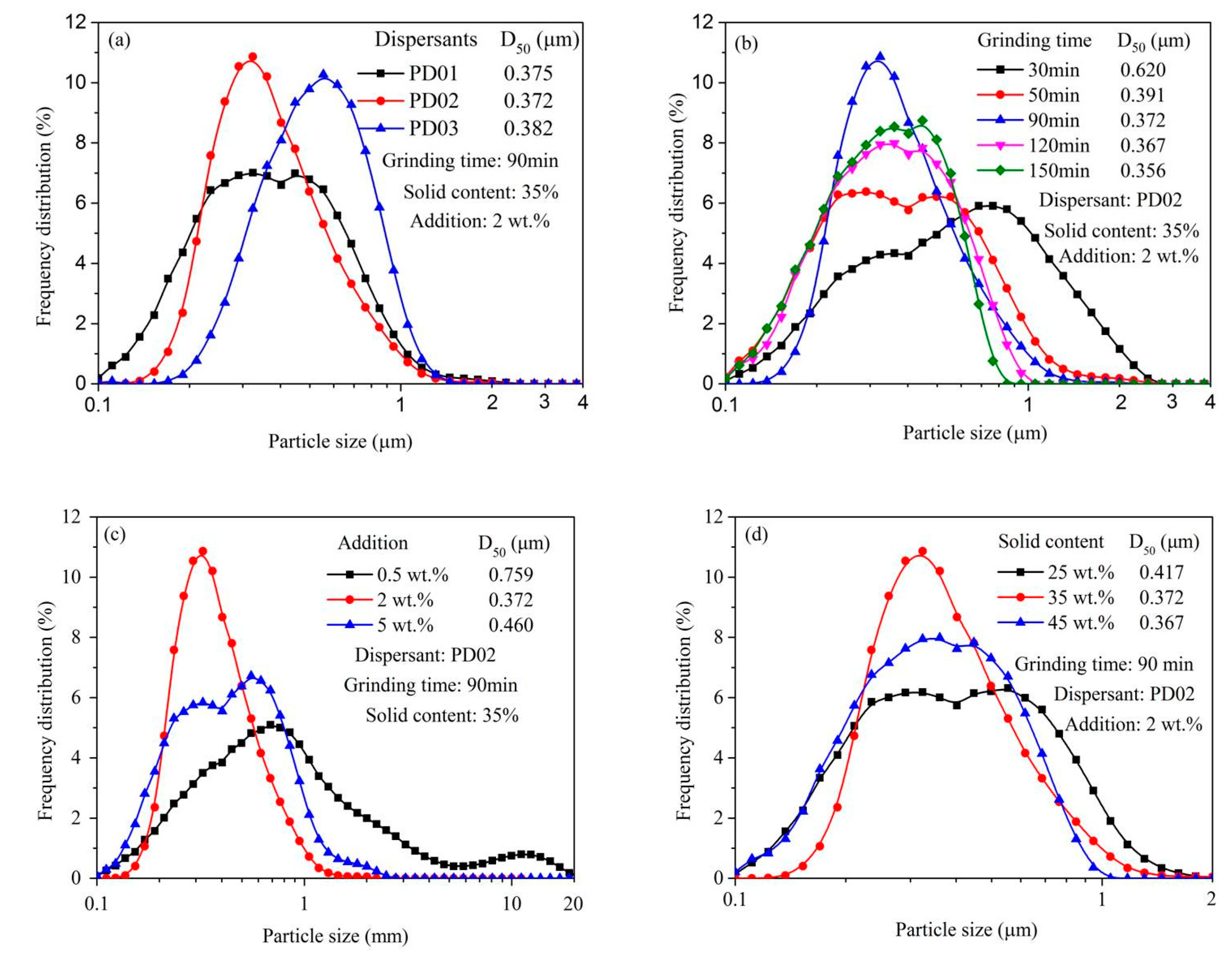
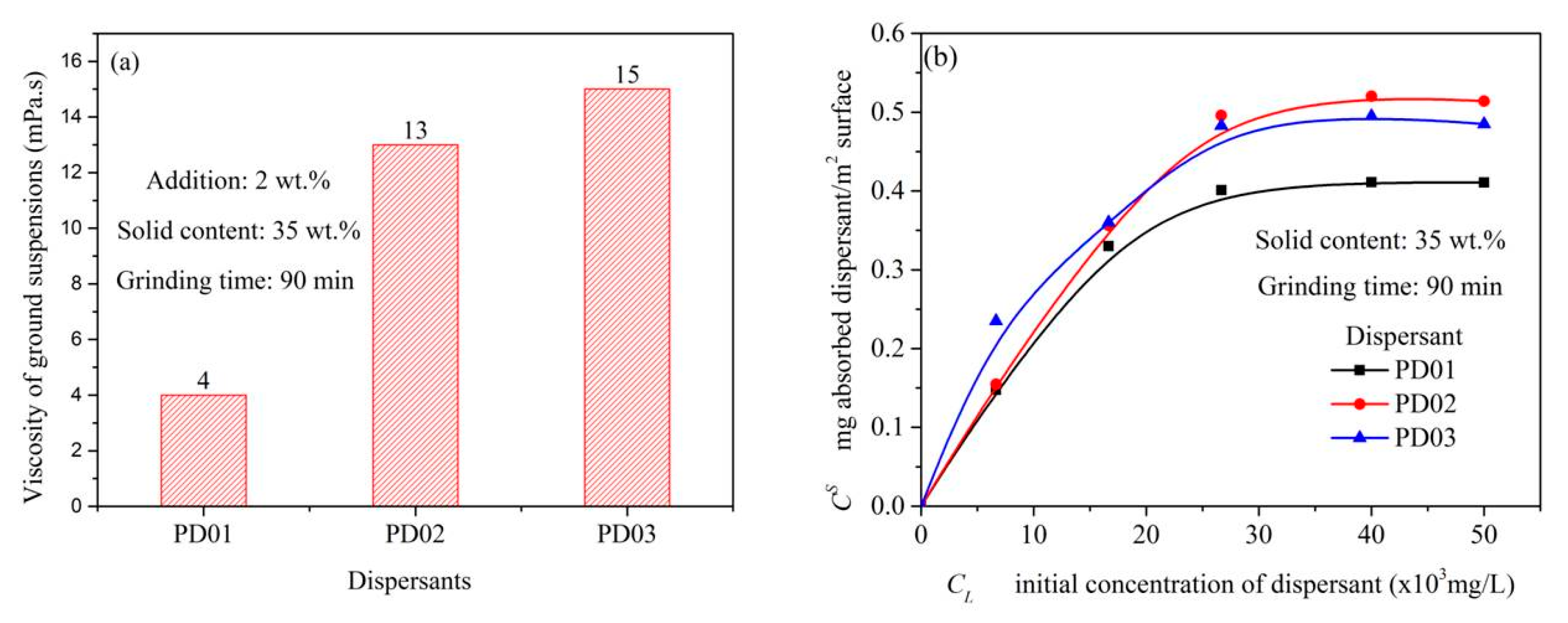
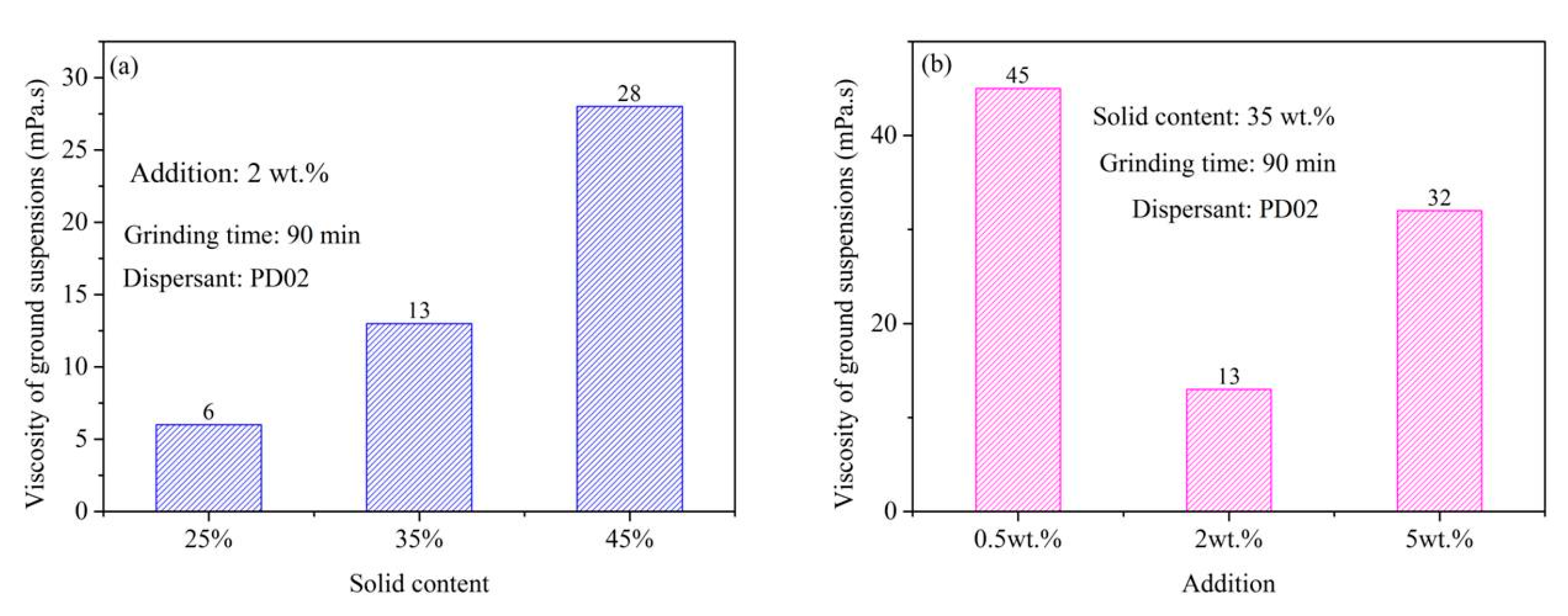
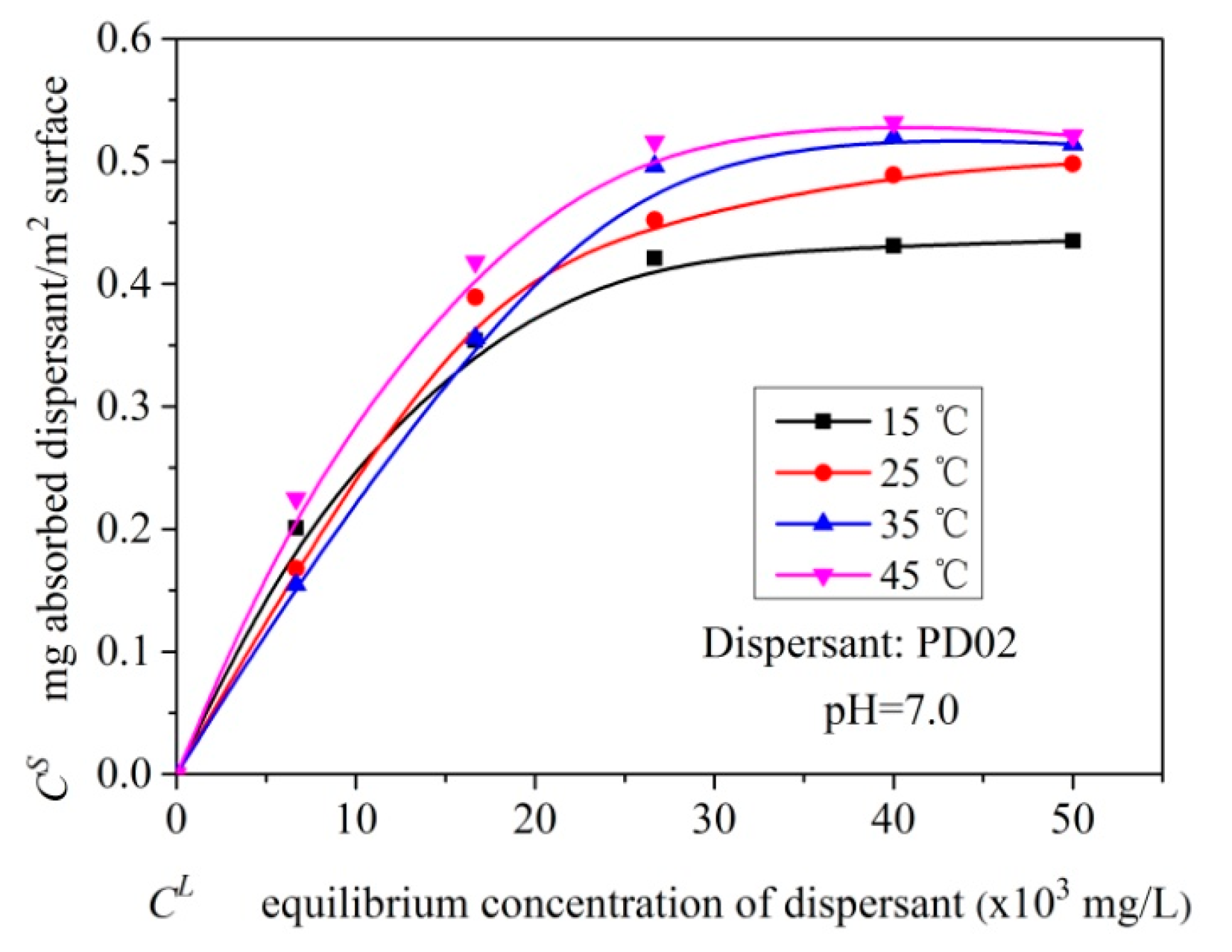
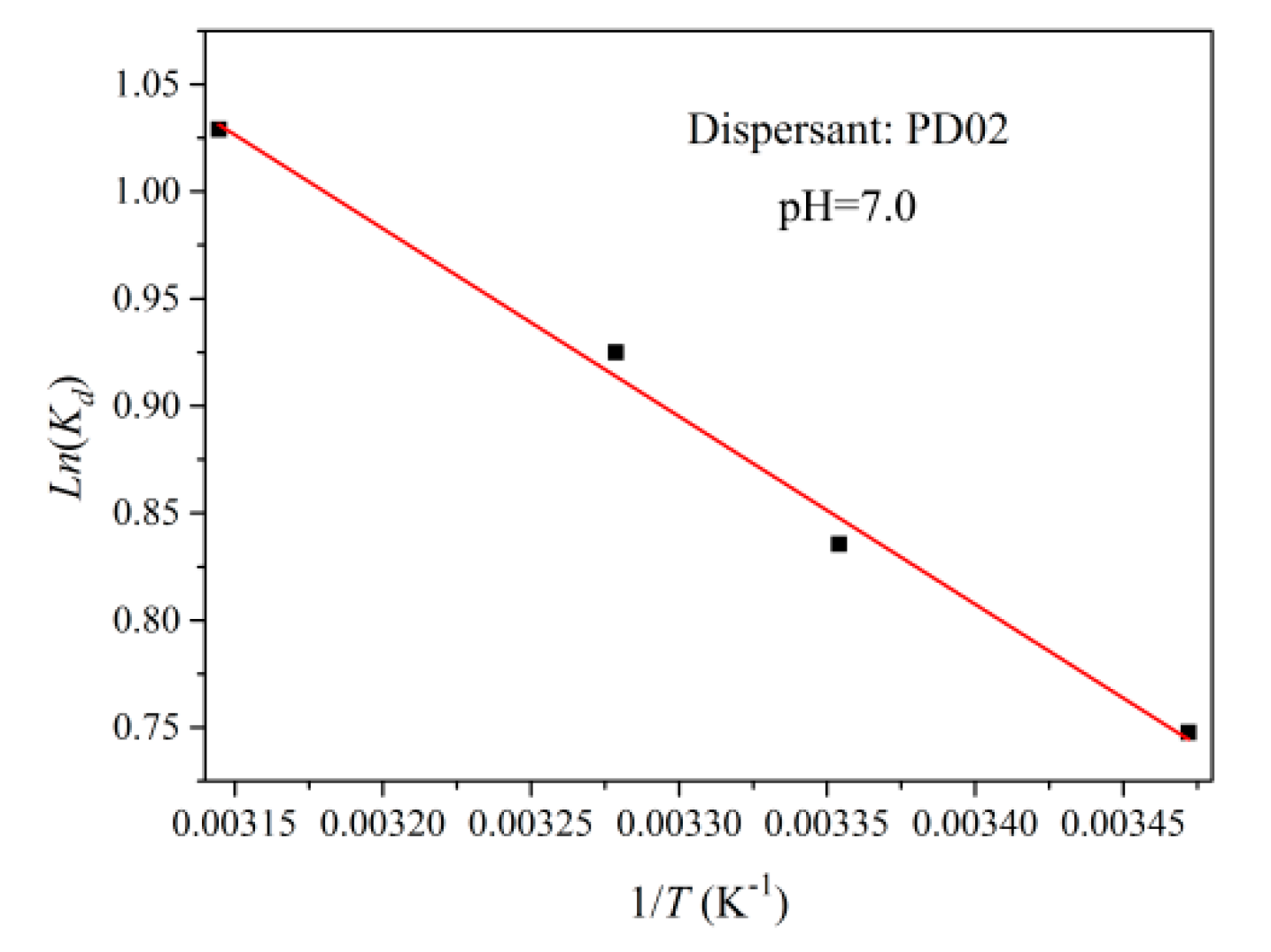
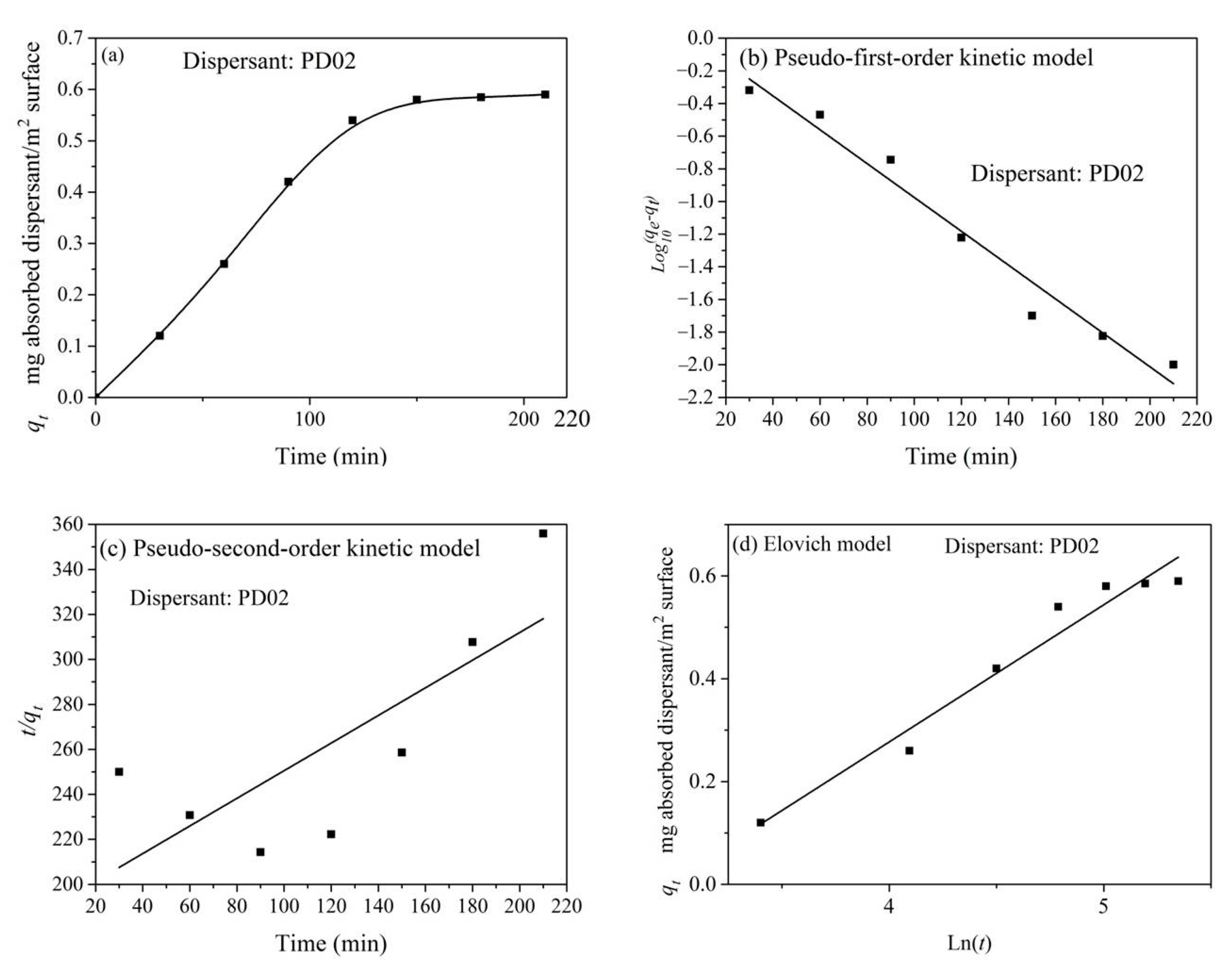
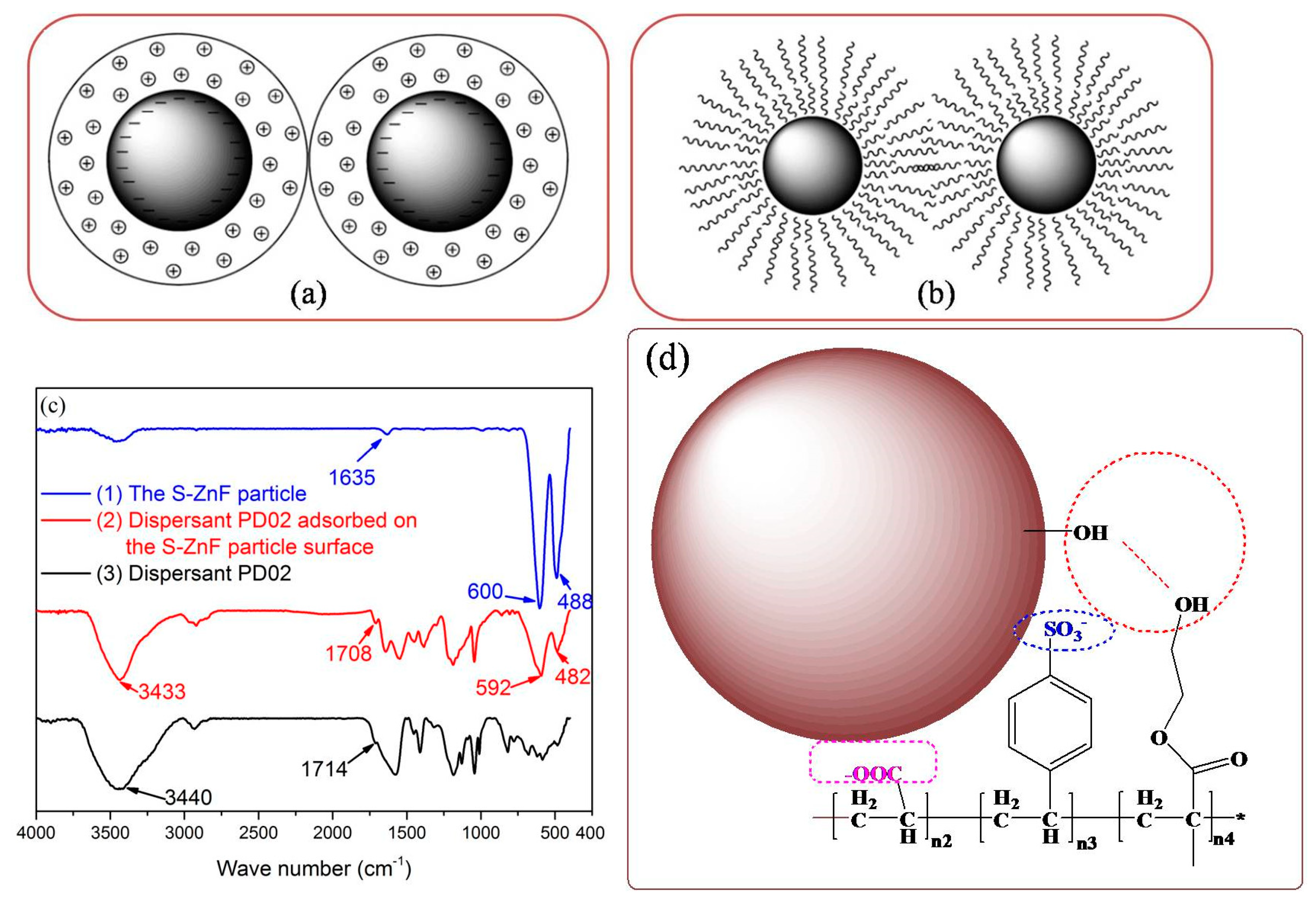
| PD0x | Mol (n1:n2:n3:n4) a | APS | Mol (APS:NaH2PO2) b | T/°C | t/h |
|---|---|---|---|---|---|
| PD01 | 0:2:1:0 | 3 wt.% | 1:10 | 85 | 10 |
| PD02 | 0:2:1:0.2 | 3 wt.% | 1:10 | 75 | 8 |
| PD03 | 0.2:2:1:0.2 | 3 wt.% | 1:10 | 80 | 8 |
| PD0x | N(%) | C(%) | H(%) | S(%) | N/C(%) |
|---|---|---|---|---|---|
| PD01 | 0.09 | 31.46 | 3.219 | 5.072 | 0.29% |
| PD02 | 0.17 | 31.07 | 3.483 | 5.711 | 0.55% |
| PD03 | 0.05 | 33.70 | 3.902 | 3.427 | 0.15% |
| PD0x | Mn | PDI | Yield |
|---|---|---|---|
| PD01 | 8576 | 3.9 | 92% |
| PD02 | 7078 | 3.5 | 99% |
| PD03 | 8893 | 4.6 | 96% |
| Langmuir Equation | Freundich Equation | |||||||
|---|---|---|---|---|---|---|---|---|
| T (°C) | Dispersant | Pigment | (L/g) | (mg/m2) | R2 | R2 | ||
| 15 | PD02 | S-ZnF | 88.1 | 0.486 | 0.9489 | 0.082 | 0.421 | 0.9674 |
| 25 | PD02 | S-ZnF | 27.6 | 0.884 | 0.9652 | 0.070 | 0.537 | 0.8503 |
| 35 | PD02 | S-ZnF | 76.2 | 0.569 | 0.9901 | 0.124 | 0.391 | 0.9644 |
| 45 | PD02 | S-ZnF | 53.5 | 0.602 | 0.9781 | 0.100 | 0.473 | 0.9572 |
| Dispersant | Pigment | ΔH (KJ/mol) | ΔS (J/molK) | R2 |
|---|---|---|---|---|
| PD02 | S-ZnF | 7.3 | 29.75 | 0.9902 |
| Pseudo-First-Order Kinetic | Pseudo-Second-Order Kinetic | ||||||
|---|---|---|---|---|---|---|---|
| Dispersant | Pigment | qe (mg/m2) | k1 (min−1) | R2 | qe(mg/m2) | k2 (min−1) | R2 |
| PD02 | S-ZnF | 0.987 | 0.0239 | 0.9627 | 1.622 | 0.0079 | 0.5177 |
| Elovich Model | ||||||
|---|---|---|---|---|---|---|
| Dispersant | Pigment | a | b | R2 | ||
| PD02 | S-ZnF | −0.79 | 0.2667 | 3.66 × 10−14 | 3.7486 | 0.9536 |
Disclaimer/Publisher’s Note: The statements, opinions and data contained in all publications are solely those of the individual author(s) and contributor(s) and not of MDPI and/or the editor(s). MDPI and/or the editor(s) disclaim responsibility for any injury to people or property resulting from any ideas, methods, instructions or products referred to in the content. |
© 2023 by the authors. Licensee MDPI, Basel, Switzerland. This article is an open access article distributed under the terms and conditions of the Creative Commons Attribution (CC BY) license (https://creativecommons.org/licenses/by/4.0/).
Share and Cite
Huang, G.; Wu, H.; Liu, Z.; Hu, H.; Guo, S. Study on the Adsorption Behavior of Polymeric Dispersants to S-ZnF Particles during Grinding Process. Materials 2023, 16, 1287. https://doi.org/10.3390/ma16031287
Huang G, Wu H, Liu Z, Hu H, Guo S. Study on the Adsorption Behavior of Polymeric Dispersants to S-ZnF Particles during Grinding Process. Materials. 2023; 16(3):1287. https://doi.org/10.3390/ma16031287
Chicago/Turabian StyleHuang, Guanghua, Haohan Wu, Zhijun Liu, Hanlin Hu, and Shifeng Guo. 2023. "Study on the Adsorption Behavior of Polymeric Dispersants to S-ZnF Particles during Grinding Process" Materials 16, no. 3: 1287. https://doi.org/10.3390/ma16031287
APA StyleHuang, G., Wu, H., Liu, Z., Hu, H., & Guo, S. (2023). Study on the Adsorption Behavior of Polymeric Dispersants to S-ZnF Particles during Grinding Process. Materials, 16(3), 1287. https://doi.org/10.3390/ma16031287







